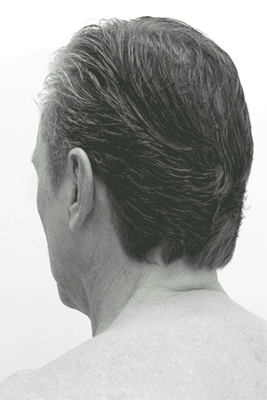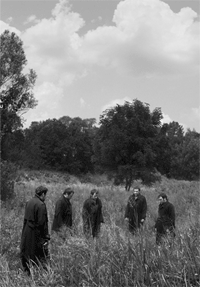
so, before i went to check out 'Young Curators, New Ideas' at
Bond Street Gallery, i
promised to come back with my take on the exhibition's offer of "where art photography is today." i did come up with an answer for your consideration, and it's posted below some thoughts on the show itself.
the show: the exhibition offers the viewpoints of six curators. though they obviously aren't all attempting to conclusively tackle the question of where art photography is in grand terms (especially given how quickly the show was put together), all six curators present themes that point toward possible answers to our question.
i'd group the exhibitions into three loose categories: 1) the first and most straightforward for me was Amy Stein's exhibition, which presents a new crop of photographers working in the directorial tradition of Sherman and Crewdson. these folks, like Alix Smith and Ofer Wolberger, are interested in identity and storytelling and photographic authority.
2) the second group i would describe as pretty pictures with themes of magic, light, and new mysticism (Grant Willing & Alana Celii and Jon Feinstein's exhibitions both explored these). i have to admit that i find a lot of these beautiful, which makes me question them a bit. there's a lot to plumb here (perhaps a few more posts worth), but for discussion-starters i liked Jon Feinstein's interview with Shoot! about the turn toward 'photographic mysticism.'
3) my final grouping was of three curators who seemed primarily interested in questioning photographic forms, and the deconstruction of the meaning of the photograph (Michael Buhler-Rose, Laurel Ptak, and Lumi Tan). obviously this topic is dear to my heart. i enjoyed Buhler-Rose's presentation of Charles Benton's "Opposing Photographers": a timed slide presentation of two guys taking pictures of each other taking pictures of each other. incredibly simple, yes, but how fun to see a thoughtful and playful meditation on one of the most common snapshot clichés. and of course, Laurel Ptak's commissioned animated GIFs stood out (not the least because so many people at the opening reception were crowded around the flatpanel screen watching them animate). of the 26 photographers who contributed GIFs, Noel Rodo-Vankuelen stole the show. (his GIFs are GIFtastic. check out his "Father" above and "Black Monolith," below.) Karly Wildenhaus's are amazing too.
many of the themes presented do overlap and coalesce toward a certain kind of vision of art photography today. but overall -- where is it at? -- i have to say there was one obvious but largely unspoken elephant in the room:
the internet. not only had i seen most of the photographs in the show online before, but the show itself definitely had a vibe of people who know each other from the internet posting up paper pictures of some of their favorite photos that they saw on different websites. i don't think this is a negative thing, but it does warrant some thought. and it is definitely something i will be pondering as i, too, contribute more posts and links about various photographs that i primarily, if not exclusively, encounter online. (of course, these questions have been tackled before,
here's one interesting and topical starting point.)
the most self-conscious exploration of
internet-as-co-curator is also the reason that the animated GIFs were so interesting: because they are a low-brow computer/online digital form being presented on an expensive television screen on a gallery wall -- not to mention being "sold" for $20 each. clever stuff. i think the only thing that could have been better than this, in terms of questioning photography and poking at its online migrations, would be to print each frame of the GIF out individually on paper and turn them into flipbooks.
for those folks who have also checked out the gallery show on Bond St. in lovely Gowanus, Brooklyn (and i do recommend that you check it out), i would love to hear your thoughts as well. Google is returning
3,700 hits for "Young Curators, New Ideas," and frankly the thought of reading them all is freaking exhausting. so i turn to you, dear readers.





















